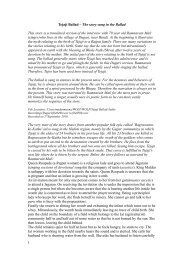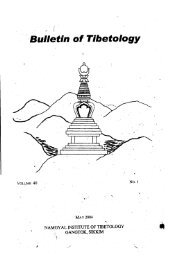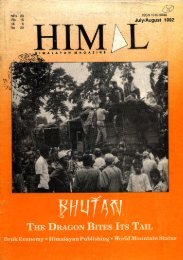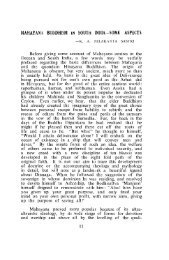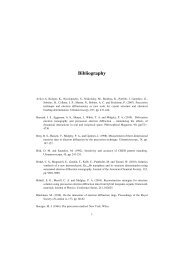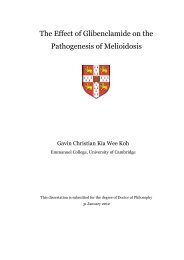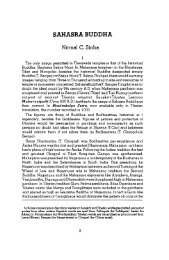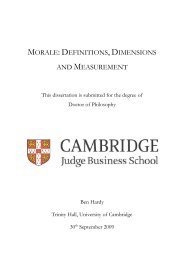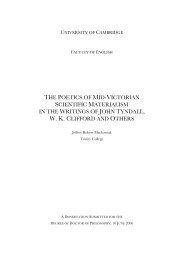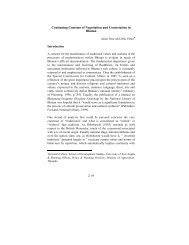The Crusades, the Genoese and the Latin East - DSpace at ...
The Crusades, the Genoese and the Latin East - DSpace at ...
The Crusades, the Genoese and the Latin East - DSpace at ...
Create successful ePaper yourself
Turn your PDF publications into a flip-book with our unique Google optimized e-Paper software.
is correct <strong>and</strong> <strong>the</strong> significance of <strong>the</strong> 1186 correspondence<br />
will<br />
be discussed in length in Chapter<br />
Four. However, <strong>the</strong> developments <strong>at</strong> <strong>the</strong> beginning of <strong>the</strong> thirteenth century have very little to do<br />
with <strong>the</strong> pre-war dem<strong>and</strong>s of <strong>the</strong> <strong>Genoese</strong>. In 1186, Pope Urban III instructed <strong>the</strong> bishop of<br />
Tripoli to encourage <strong>the</strong> count of Tripoli to give <strong>the</strong> <strong>Genoese</strong> one-third of <strong>the</strong> city of Tripoli as<br />
had been promised to <strong>the</strong>m <strong>at</strong> <strong>the</strong> beginning of th<strong>at</strong> century: `... eundem comitem diligenter<br />
moneas et inducas ut vel eisdem civibus terciam illam partem absque dicult<strong>at</strong>e restituas. ' <strong>The</strong><br />
bishop was also instructed to use <strong>the</strong> ecclesiastical stick if necessary: `si facere forte noluerit, tu<br />
eum ad hoc ecclesiastica districtione appell<strong>at</strong>ione cessante compellas. '208 <strong>The</strong> letter which <strong>the</strong><br />
pope wrote to <strong>the</strong> count himself was along <strong>the</strong> same lines, only more polite 209 <strong>The</strong>se dem<strong>and</strong>s<br />
were never realised, of course, because <strong>the</strong> conflict became irrelevant when Saladin conquered<br />
<strong>the</strong> territory. Interestingly, when <strong>the</strong> crusader st<strong>at</strong>es were re-established <strong>the</strong>se <strong>Genoese</strong> dem<strong>and</strong>s<br />
in Tripoli <strong>and</strong> Gibelet were not simply reduced but never mentioned again. Genoa did not bring<br />
up its old claims even when it l<strong>at</strong>er negoti<strong>at</strong>ed with Bohemond IV in 1203 <strong>and</strong> in 1205.<br />
Local developments in Tripoli <strong>and</strong> Antioch urged <strong>the</strong>se political changes too. Bohemond<br />
IV was <strong>the</strong> person behind many of <strong>the</strong> changes th<strong>at</strong> happened in <strong>the</strong> nor<strong>the</strong>rn st<strong>at</strong>es in this period.<br />
In 1201, Bohemond made his first military collabor<strong>at</strong>ion with <strong>the</strong> Ayyubid ruler of Aleppo al-<br />
Malik az-Zähir. Peter Edbury suggested th<strong>at</strong> <strong>the</strong> motiv<strong>at</strong>ion for this Ayyubid support was th<strong>at</strong> al-<br />
Malik `preferred a compar<strong>at</strong>ively weak <strong>L<strong>at</strong>in</strong> prince in Antioch to <strong>the</strong> king of a much enlarged<br />
Armenian kingdom '210 This<br />
. comment puts <strong>the</strong> political <strong>and</strong> economic developments in <strong>the</strong> region<br />
in <strong>the</strong> context of <strong>the</strong> conflict between King Leon of Armenia <strong>and</strong> Prince Bohemond III over<br />
Antioch, a conflict which began shortly after <strong>the</strong> end of <strong>the</strong> Third Crusade. However, when<br />
Bohemond IV became <strong>the</strong> Prince of Antioch in 1201 he made a str<strong>at</strong>egic decision <strong>and</strong> came to<br />
terms with al-Malik az-Zähir.<br />
This political step had opened up many new commercial opportunities which spelled<br />
economic prosperity for all sides involved. <strong>The</strong> <strong>Genoese</strong> hastened<br />
to seize this opportunity. At <strong>the</strong><br />
beginning of <strong>the</strong> thirteenth century <strong>the</strong> rel<strong>at</strong>ionship between Bohemond IV <strong>and</strong> <strong>the</strong> de Biblio was<br />
strong. One of Bohemond's closest companions <strong>at</strong> <strong>the</strong> time was Guy de Biblio, <strong>the</strong> lord of<br />
Gibelet. Guy descended<br />
from <strong>the</strong> <strong>Genoese</strong> family Embriaco but, as will be discussed in Chapter<br />
Four, he did not refer to himself as an Embriaco or as <strong>Genoese</strong>. Bohemond IV married Placentia<br />
de Biblio, Guy's sister <strong>and</strong> he gave his own sister's h<strong>and</strong> to Guy 211 <strong>The</strong> important role th<strong>at</strong> <strong>the</strong><br />
members of <strong>the</strong> de Biblio family played in Bohemond's court may be seen in <strong>the</strong> fact th<strong>at</strong> <strong>the</strong>y<br />
2081<br />
Libri lurium, vol. 1/2, number 323, p. 128.<br />
2091<br />
Libri lurium, vol. 1/2, number 322, pp. 126-7.<br />
210<br />
Peter Edbury, `<strong>The</strong> Crusader St<strong>at</strong>es' in David Abulafia (ed. ) <strong>The</strong> New Cambridge Medieval History<br />
vol. 5 (Cambridge, 1999), p. 597.<br />
211<br />
See Claude Cahen, La Syrie du Nord a l'epoque des croisades et la principaute franque d'Antioche<br />
(Paris, 1940), p. 608<br />
70<br />
,



